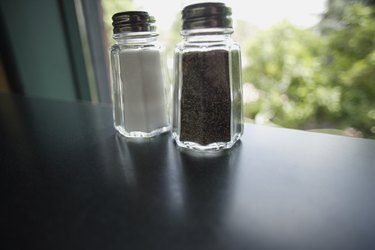
Iodine and iron are both minerals needed for good health. If you live in the United States or other developed countries, iodine deficiencies are rare because table salt contains the mineral, as does most of the farmland in which food is grown. Iron deficiencies, on the other hand, exist around the world. Food and supplements can help address nutrition gaps from either mineral, but check with your doctor before making any major changes to your diet.
Iodine Uses
Video of the Day
Iodine helps regulate your thyroid hormone levels, preventing hypothyroidism, which can threaten proper development in children and cause weakness, skin disorders and weight gain in some people. Goiter, in which the thyroid becomes enlarged, results from too little iodine, although excess iodine might also lead to goiter. Some doctors prescribe iodine supplements to people experiencing breast tenderness relating to their menstrual cycles. Topical iodine treats wounds, oral inflammation and vaginitis.
Video of the Day
Iodine Sources
According to UMMC, the average person gets most of her iodine from table salt. Foods such as brown kelp, shellfish and deep-water fish draw the mineral from the ocean. Iodine-enriched breads, spinach, turnip greens, Swiss chard, soybeans and summer squash also contribute iodine. People with deficiencies might opt to take seaweed-based supplements or multivitamins containing iodine. Drugstores carry liquid iodine solutions for topical use on wounds or infections.
Iron Uses
Getting enough iron helps prevent anemia, the disorder that results in extreme tiredness and fatigue. When you don't have enough iron in your system, you don't produce enough hemoglobin, which is responsible for transporting oxygen throughout your body. Even if you don't have anemia, low levels of iron can interfere with body function, making you more tired than normal and interfering with sports and workouts. Proper iron intake is also crucial for proper growth in children and might soothe coughs for people on ACE inhibitors.
Iron Sources
While plant-based foods high in iron exist, they contain nonheme iron, which means the body doesn't absorb them as easily as heme iron. Heme iron foods include liver, oysters, red meat, fish, chicken and turkey. Spinach and other dark greens, nuts, seeds, molasses, whole grains and dry beans head the list of nonheme iron foods. Vitamin C foods such as citrus fruits, spinach and tomatoes help your body absorb either kind of iron more efficiently. Iron supplements are also available.
Overdose Dangers
Too much table salt or too many iodine supplements might result in dangerous levels of the nutrients. Risks from excess iodine include thyroid conditions such as Graves' disease, Hashimoto's disease and some forms of thyroid cancer. Toddlers should not exceed more than 200 mcg daily; children 4 to 8, 300 mcg; children 9 to 13, 600 mcg; teens, 900 mcg and adults 1,100 mcg (1.1 mg). Too much iron can cause digestive ailments such as heartburn and constipation. In more serious cases, people with iron overdoses carry a slightly higher risk for developing heart disease and certain types of cancer. The Linus Pauling Institute warns that children should not take more than 40 mg of iron each day, and teens and adults should not exceed 45 mg. Death might result from extremely high doses of either iron or iodine. Always see a doctor to confirm mineral deficiencies before attempting to treat those nutritional gaps yourself.